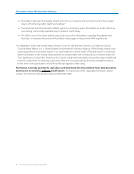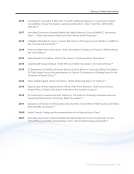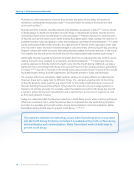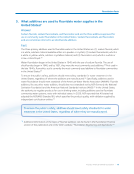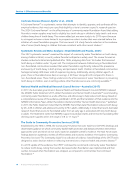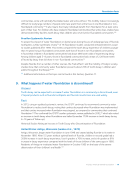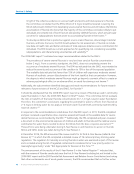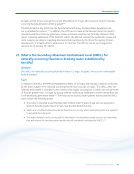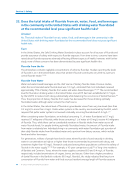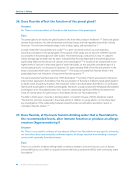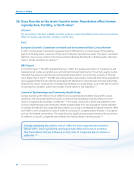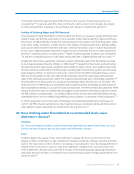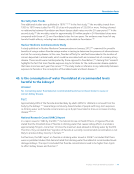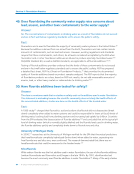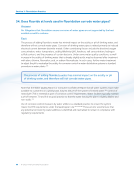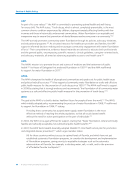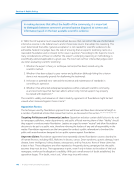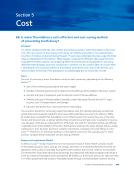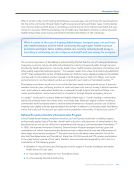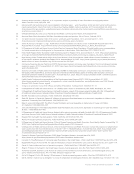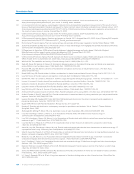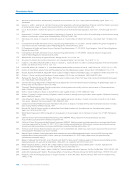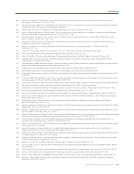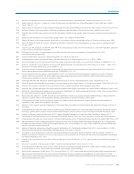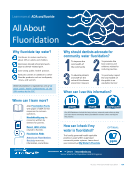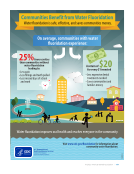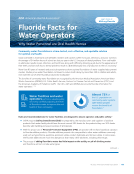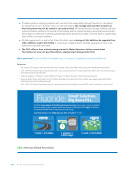© 2025 American Dental Association l 59
Fluoridation Facts
The OTC drugs listed in these regulations are generally recognized as safe and
effective by the FDA. Fluoride toothpaste is just one in a long list of OTC products
that carries a warning label.
31. Is fluoride, as provided by community water fluoridation, a toxic
substance?
Answer
No. Fluoride in water at the recommended level is not toxic according to the best available scientific
evidence.
Fact
Like many common substances essential to life and good health–salt, iron, vitamins A and D, chlorine,
oxygen, and even water itself–fluoride can be toxic in massive quantities. Toxicity is generally related
to dose. While large doses of fluoride could be toxic, it is important to recognize the difference between
the effect of a massive dose of an extremely high level of fluoride versus the fluoride level currently
recommended for public water systems. Fluoride at the much lower recommended concentrations
(0.7 mg/L) used in community water fluoridation is not harmful or toxic.39
Fluoride at the much lower recommended concentrations (0.7 mg/L) used in
community water fluoridation is not harmful or toxic.
The single dose (consumed all at one time) of fluoride that could cause acute fluoride toxicity is 5 mg/
kg of body weight (11 mg/kg of body weight of sodium fluoride).275 This dose is sometimes called the
probable toxic dose (PTD), which is defined “as the minimum dose that could cause serious or life-
threatening systemic signs and symptoms and that should trigger immediate therapeutic intervention
and hospitalization.”275 Acute fluoride toxicity occurring from the ingestion of optimally fluoridated
water is impossible.275 With water fluoridated at 1 mg/L, an individual would need to drink five (5 L)
liters of water for every kilogram of body weight. For example, for an adult male (155 pound/70.3 kg
man), it would require that he consume more than 350 L (nearly 93 gallons) of water at one time to
reach an acute fluoride dose. With optimally fluoridated water now set at 0.7 mg/L fluoride, it would
take almost 30% more, or nearly 120 gallons (more than 1,900 8-ounce glasses) of water, at one time
to reach the acute dose. To address potential concerns from parents regarding young children, let’s
consider a 4-year-old child weighing approximately 36 pounds (16 kg). At 0.7 mg/L, this child would
need to drink 114 L (about 30 gallons or 475 8-ounce glasses) of water at one time to reach an acute
toxic dose. For comparison, a 3-year-old weighing around 30 pounds (13.6 kg) would need to consume
95 L (about 25 gallons or 400 8-ounce glasses) at one time. These hypothetical figures are intended
to highlight how unrealistic it is for anyone–child or adult–to consume the volume of water required
for acute fluoride toxicity from optimally fluoridated water.
Fluoridation Facts
The OTC drugs listed in these regulations are generally recognized as safe and
effective by the FDA. Fluoride toothpaste is just one in a long list of OTC products
that carries a warning label.
31. Is fluoride, as provided by community water fluoridation, a toxic
substance?
Answer
No. Fluoride in water at the recommended level is not toxic according to the best available scientific
evidence.
Fact
Like many common substances essential to life and good health–salt, iron, vitamins A and D, chlorine,
oxygen, and even water itself–fluoride can be toxic in massive quantities. Toxicity is generally related
to dose. While large doses of fluoride could be toxic, it is important to recognize the difference between
the effect of a massive dose of an extremely high level of fluoride versus the fluoride level currently
recommended for public water systems. Fluoride at the much lower recommended concentrations
(0.7 mg/L) used in community water fluoridation is not harmful or toxic.39
Fluoride at the much lower recommended concentrations (0.7 mg/L) used in
community water fluoridation is not harmful or toxic.
The single dose (consumed all at one time) of fluoride that could cause acute fluoride toxicity is 5 mg/
kg of body weight (11 mg/kg of body weight of sodium fluoride).275 This dose is sometimes called the
probable toxic dose (PTD), which is defined “as the minimum dose that could cause serious or life-
threatening systemic signs and symptoms and that should trigger immediate therapeutic intervention
and hospitalization.”275 Acute fluoride toxicity occurring from the ingestion of optimally fluoridated
water is impossible.275 With water fluoridated at 1 mg/L, an individual would need to drink five (5 L)
liters of water for every kilogram of body weight. For example, for an adult male (155 pound/70.3 kg
man), it would require that he consume more than 350 L (nearly 93 gallons) of water at one time to
reach an acute fluoride dose. With optimally fluoridated water now set at 0.7 mg/L fluoride, it would
take almost 30% more, or nearly 120 gallons (more than 1,900 8-ounce glasses) of water, at one time
to reach the acute dose. To address potential concerns from parents regarding young children, let’s
consider a 4-year-old child weighing approximately 36 pounds (16 kg). At 0.7 mg/L, this child would
need to drink 114 L (about 30 gallons or 475 8-ounce glasses) of water at one time to reach an acute
toxic dose. For comparison, a 3-year-old weighing around 30 pounds (13.6 kg) would need to consume
95 L (about 25 gallons or 400 8-ounce glasses) at one time. These hypothetical figures are intended
to highlight how unrealistic it is for anyone–child or adult–to consume the volume of water required
for acute fluoride toxicity from optimally fluoridated water.










